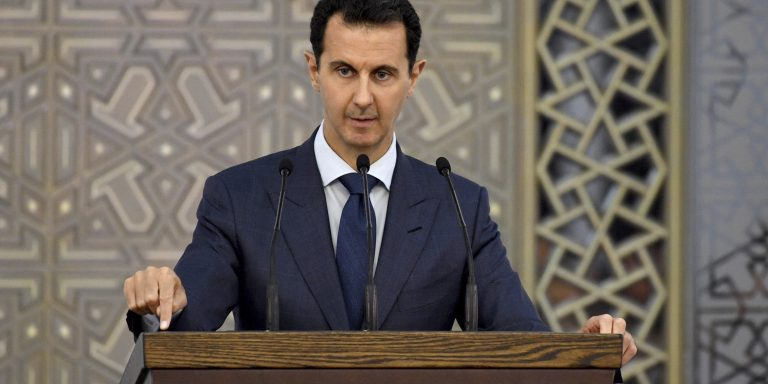
The regime of Syrian President Bashar al-Assad faces renewed threats to its grip on power as Russia redeploys personnel and equipment to Ukraine.
Russia has sought to preserve its gains in Syria in part by engaging and seeking to coordinate Syria policy with Turkey.
Assad’s dependence on Iran has increased as Russia focuses on Ukraine, but Iran’s interests sometimes conflict with those of the Syrian government.
As external powers jockey for advantage in Syria, the humanitarian situation continues to deteriorate, including an outbreak of cholera in both government and opposition-held territory.
After more than a decade of civil war and what has been widely reported for the past several years as a re-capture of most of Syria by President Bashar al-Assad’s regime, the government’s fortunes, and the welfare of Syria’s citizens, are jeopardized by a complex mix of events and agendas. Paulo Sérgio Pinheiro, chair of the United Nations Independent International Commission of Inquiry on the Syrian Arab Republic, told the U.N. Human Rights Council on September 22: “The war is not over despite a general reduction in fighting. Hostilities are intensifying on several fronts.” A recent U.N. report covering events in early 2022 states, “Insecurity continued in government-controlled areas, particularly in the south of the country…The repositioning of Russian forces [in the south] demonstrated the fragility of current security arrangements, as did the continued reliance on Government-affiliated militias and armed groups, who are implicated, among others, in a booming drug trade.” In northern Syria, government forces have continued to battle the opposition that is confined largely to Idlib province, but enjoys the backing of neighboring Turkey. Much of eastern Syria is controlled by a mix of militias backed by Russia, the Syrian government, Iran, Turkey, and the United States – all of which are using Syrian militias as proxy forces against their regional adversaries or Islamic State forces still active in parts of Syria.
Russia’s major setbacks in its war in Ukraine have caused significant concern, although not panic, in Damascus. Iranian intervention in the Syrian civil conflict in 2013 helped stave off Assad’s defeat, but it has been Russian air strikes and ground units that helped Assad recapture much of the country by 2018. In need of more forces in Ukraine, Moscow has been redeploying some of the estimated 60,000 military personnel that were based in Syria at the height of the civil conflict since mid-2022. In May, the independent Moscow Times reported that several Russian military units had been relocated from bases across Syria to three airports on Syria’s Mediterranean coast, for ongoing transfer to Ukraine. In September, coinciding with Russia’s announcement of a “partial mobilization” of Russian reservists, news outlets reported that Russia decided to move units of its 217th Paratroop Regiment from Syria to Ukraine. Russia also has used its veto power on the U.N. Security Council to constrain a U.N.-backed cross-border aid program as pressure on the international community to engage diplomatically with the Assad government and reintegrate it into the regional and international fold. Yet, Russian pressure on Assad to compromise with his political opposition – a pre-requisite to ending the civil conflict completely – has been unsuccessful to date.
Perhaps to stabilize the Assad regime before drawing Russian forces down further, President Vladimir Putin and his aides have stepped up their engagement with Turkey’s President Recep Tayyip Erdogan and his intelligence aides in recent months, including an August bilateral summit in Sochi, Russia. Russia and Turkey appear to have agreed to a Turkish reconciliation with Assad, apparently in exchange for tacit acquiescence to Turkey’s planned operations to expand a security zone along its border with Kurdish-controlled territory in northeastern Syria. Russia’s drawdown in Syria is, at the same time, enhancing the leverage of Iran and its allies – whose agendas sometimes differ from those of the Assad government. Some of the bases that Russian forces have evacuated have reportedly been taken over by Iranian forces and those of its ally, Lebanese Hezbollah. Both Russia and Iran seek to secure Assad in power; however, Iran also seeks to secure its supply lines to Hezbollah and use Syrian territory to pressure its primary adversaries Israel and the United States. Iran-backed militias have recently conducted unsuccessful drone and rocket strikes on bases in eastern Syria manned by U.S. and allied Syrian forces, including at Al Tanf. The United States has, on some occasions, retaliated against Iran-backed militia forces inside Syria. Iran’s buildup of military production infrastructure has attracted repeated strikes by Israel, including a June strike on Damascus airport. The Israeli strikes undermine Damascus’ war effort against its armed opponents.
The primary victims of the protracted conflict in Syria have been civilians, both those in areas under government control as well as the nearly 7 million internally displaced persons, of which over two million people live in 1,760 informal settlements and planned camps. According to a February assessment by the U.N. Office for the Coordination of Humanitarian Affairs, in 2022, 14.6 million Syrians were in need of humanitarian assistance, an increase of 1.2 million from 2021. The report added that Syria requires one of the largest humanitarian responses in the world, with assistance delivered to 6.8 million people per month. The June closure of Damascus airport, caused by the Israeli airstrike, resulted in the suspension of all flights for the U.N. Humanitarian Air Service (UNHAS) – the key enabler of access for humanitarian operations in Syria and in many other crisis countries.
Earlier this month, Syrian health authorities reported on an outbreak of cholera, which has since ballooned to over 2,000 suspectedcases throughout and resulted in at least 29 reported deaths. Centered in regime-controlled Aleppo and in opposition-controlled territory in the north, some fear that cases have been significantly under-reported. All available reports from U.N. and other organizations suggest that, with security continuing to deteriorate in Syria, and no political solution in sight, the humanitarian situation for the Syrian people is unlikely to improve any time soon.
